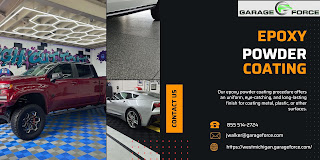Get the Unveiling Benefits of Powder Coating - A Complete Guide
In the realm of protective coatings, epoxy powder coating stands out as a versatile and effective solution that has gained widespread popularity across various industries. This dry-finishing process offers a multitude of benefits, ranging from durability to environmental friendliness. In this blog, we'll delve into the benefits of powder coating, a preferred choice for enhancing and protecting surfaces.
1.
Exceptional
Durability: Epoxy powder coating
is renowned for its outstanding durability. Once applied and cured, it forms a
robust and resilient layer on the substrate, protecting against corrosion,
abrasion, and impact. This durability makes it an ideal choice for surfaces
subjected to challenging environments, ensuring longevity and reduced
maintenance costs.
2.
Uniform Coating
Thickness: The electrostatic application process
of epoxy powder coating ensures an even and uniform coating thickness across
the entire surface. This results in a smooth and consistent finish, enhancing
both the aesthetics and functionality of the coated object. Whether it's a
complex metal component or a simple household item, epoxy powder coating
delivers a professional and high-quality appearance.
3.
Environmental
Friendliness: Unlike some liquid
coatings that contain high levels of volatile organic compounds (VOCs), epoxy
powder coatings are relatively environmentally friendly. The application
process generates minimal waste, and the reduced VOC content contributes to a healthier
and safer working environment. This aligns with the growing emphasis on
sustainable and eco-friendly practices in modern industries.
4.
Versatility in
Applications: Epoxy powder
coating finds applications across many industries. From automotive components
and household appliances to architectural elements and outdoor furniture, the
coating method adapts to various substrates and surfaces. Its versatility
allows for creative and customized finishes, making it a popular choice for
both decorative and protective purposes.
5.
Cost-Efficiency: While the initial investment in epoxy powder coating equipment and
application may seem higher than traditional coating methods, the long-term
cost savings offset the upfront expenses. The durability of the coating reduces
the need for frequent maintenance and recoating, ultimately saving both time
and resources.
6. Resistance to Chemicals: Epoxy powder coatings exhibit excellent resistance to chemicals, making them suitable for environments where exposure to harsh substances is common. This resistance adds another layer of protection, ensuring the integrity of the coated surface even in challenging industrial settings.
A Few Difference between Powder Coating and Paint
Powder coating and traditional paint are both methods of applying a protective finish to surfaces, but they differ in several key aspects. Here are some notable points on powder coating vs paint:
1.
Application Method:
·
Powder Coating: Applied as a dry powder using an electrostatic spray gun. The
powder adheres to the surface due to electrostatic attraction and is then cured
in an oven.
· Paint: Applied as a liquid using brushes, rollers, or sprayers. It contains solvents that evaporate during the drying process, leaving behind a solid paint film.
2.
Adhesion Process:
·
Powder Coating: Relies on electrostatic forces to attract and adhere the powder
particles to the substrate, creating a strong bond.
· Paint: Adheres through a combination of physical and chemical bonds with the substrate. Surface preparation is crucial for proper adhesion.
3. Environmental Impact:
·
Powder Coating: Typically contains fewer volatile organic compounds (VOCs) than
liquid paint, making it more environmentally friendly and reducing air
pollution.
·
Paint: Can release VOCs during the application and drying process,
contributing to air pollution and potential health concerns.
4.
Uniformity and
Thickness:
·
Powder Coating: Provides a more even and uniform coating thickness due to the
electrostatic application process, resulting in a smooth finish.
·
Paint: May exhibit variations in thickness, and achieving a consistent
coating can be more challenging.
5.
Curing Process:
·
Powder Coating: Requires curing in an oven to melt and flow the powder, creating a
durable and hardened finish.
·
Paint: Dries through the evaporation of solvents or chemical reactions,
and curing times can vary based on the type of paint.
6.
Durability and
Resistance:
·
Powder Coating: Generally offers superior durability providing resistance to
impact, chemicals, corrosion, and UV radiation.
·
Paint: May require additional coatings or protective layers to achieve
similar levels of durability and can be more susceptible to chipping and
peeling.
7.
Waste Generation:
·
Powder Coating: Generates minimal waste since overspray can often be collected and
reused.
· Paint: May generate more waste, and proper disposal of paint-related materials is essential to minimize environmental impact.
8.
Color Options and
Finish
·
Powder Coating: Offers various colors and finishes, including textured and
metallic options.
·
Paint: Provides diverse color choices but may require additional steps
for achieving certain finishes.
Understanding these differences can help in choosing the most suitable coating method based on specific application requirements, desired finish, and environmental considerations.
Conclusion
Epoxy powder coating emerges as a
reliable and efficient solution for achieving durable, high-quality finishes on
many surfaces. Polyurea garage floor coating will
have numerous benefits, including exceptional durability, uniform
coating thickness, environmental friendliness, versatility, cost-efficiency,
and chemical resistance, positioning it as a go-to choice for industries
seeking reliable and long-lasting protective coatings. As technology continues
to advance, epoxy powder coating remains a key player in the ever-evolving
landscape of surface finishing.

.jpg)
.jpg)
Comments
Post a Comment